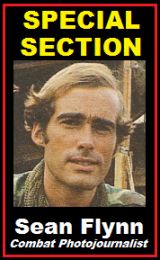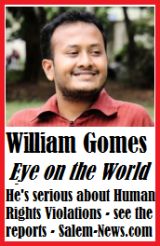
Publisher:
Bonnie King
CONTACT:
Newsroom@Salem-news.com
Advertising:
Adsales@Salem-news.com

~Truth~
~Justice~
~Peace~
TJP
Dec-18-2011 12:58

 TweetFollow @OregonNews
TweetFollow @OregonNews
Border Crossers Encounter New Delays
Kent Paterson for Salem-News.com“The principal mission of US Customs and Border Protection (CBP) is anti-terrorism” - agency statement
 U.S. border crossing with Mexico |
(LAS CRUCES, N.M.) - In an e-mail to constituents this month, El Paso Congressman Silvestre Reyes lauded the November opening of a new, high-tech pedestrian crossing system at the Paso del Norte (Santa Fe) Bridge between Ciudad Juarez and El Paso. With assistance from the Unisys Corporation, the maze-like system uses a combination of revolving doors, hand-held mobile devices and radio frequency identification (RFID) to process US passports; ten fingerprint biometric capture devices were also installed for inclusion in the system, according to Unisys.
“This will cut down the time it takes to help each individual, particularly during the busiest closing times,” Congressman Reyes wrote to his constituents.
According to US Customs and Border Protection (CBP), the idea is to eliminate the time inspection officers spend manually entering document information into a computer as well as increase security for officers. Also touted by Unisys as heralding a 21st century approach to processing millions of crossings every year, the El Paso system was erected under a 2010 contract awarded to the company.
But on recent days, pedestrians crossing the Paso del Norte Bridge into El Paso have encountered long delays. A little more than three weeks after the new pedestrian processing lanes were opened up, this reporter and a friend spent about 1 hour and 40 minutes waiting to cross back into El Paso.
The line was very short, and under the old, low-tech system it might have taken 20 or 30 minutes to get through the security check. In fact, the line for US passport holders was much shorter than a parallel line for non-passport holders, though the latter was moving along the bridge and into the customs building at a much quicker pace.
Although US passport holders soon discovered that they had to scan their documents into two separate machines before reaching an inspection officer at a booth, no CBP personnel were present to provide instructions. Indeed, as the reporter’s friend pointed out, it wasn’t even clear from the get go what the difference was between the US passport line and the non-passport one outside the building. Occasionally, a CPB officer would appear at the front of the lines and let small groups inside before halting the remaining crossers again.
“That’s ridiculous,” was Claudia Ordaz’s surprised reaction to a rehash of this reporter’s experience. The press secretary for Reyes, Ordaz said the Texas Democrat was present for the inauguration of the new system last month.
“We were looking at the process. It looked orderly and looked consistent,” Ordaz told Frontera NorteSur.
Two weeks later, members of Reyes’ staff went back to see how the CBP new system was functioning. Ordaz urged bridge crossers to contact her office with any “suggestions” or concerns about the new system.
The day prior to this reporter’s experience, Vicky Gaubeca had similar problems navigating the new system. “It’s the longest time I’ve ever had to get through,” Gaubeca said, calculating her crossing time at 1 hour and 15 minutes. The director of the American Civil Liberties Union-New Mexico Regional Center for Border Rights in Las Cruces, Gaubeca is no stranger to travel requirements and border security policies.
“It wasn’t clear how you were supposed to put the passport,” Gaubeca said of the new machines. “People behind me were trying to tell me how to put the passport in,” she said. “In my opinion, it totally holds up the line. It doesn’t seem user friendly.” Like this reporter, Gaubeca said she did not see CBP personnel advising people on how to scan the passports. Hint: the trick is to find the little tabs that hold the passports.
Roger Maier, spokesman for CBP in El Paso, said he wasn’t aware of any complaints about the new system other than “media inquiries.” Maier stressed that the new pedestrian crossing system is a pilot project, and its future was dependent on a pending assessment by his agency.
Maier added that the CPB was aiming for “significant time savings” along the lines of a redone vehicle lane which was officially determined as decreasing processing times by 20 percent. Overall, the recent enhancements at the Paso del Norte Bridge cost CBP in the neighborhood of $3 million, Maier said.
“We remain hopeful that if proven successful we could deploy this nationwide,” he added.
Considering the high-tech nature of the system, Maier was asked if back-up systems were available in the event of an electronic failure. The answer was yes, though traffic would move at a “slower rate.”
According to Maier, an independent review of the project is scheduled for the early spring of 2012.
In El Paso-Ciudad Juarez, border crossing time- for both pedestrians and drivers has real consequences IN daily life. While many outside the region harp on violence and lawbreaking, residents of the sister cities engage in countless personal and business interactions, the vast majority of them legal. Late crossings could mean missed classes and appointments, lost business and canceled family gatherings.
Long crossing times create personal problems of all sorts. Within the past year, this reporter has variously witnessed an elderly woman pedestrian collapse in line and a large crowd in the non-passport line get very agitated and shouting out after waiting three or four hours to cross. If this month’s wacky weather is a foretaste of a predicted bitter winter, the long waits outside the customs building could turn into a public health issue. Conversely, last summer’s blazing temperatures that tipped well above the 100-degree mark, likewise pose risks for people waiting hours in line.
Last week, a Ciudad Juarez business leader publicly called on his compatriots to quit making trips to El Paso for three days. Federico Ziga Martinez, president of the Canirac restaurant and food association, was quoted in the Norte daily saying that US border security officers treated Juarez residents “like delinquents.” For reasons of “Mexican dignity,” Juarenses should stay away from the US city for three days in order to send a message, Ziga said.
Even a three-day boycott would be bad news to El Paso businesses, which depend on shoppers from across the border, especially during the critical winter holiday season.
“A lot of our merchants, and I have 400 members, make their livelihood from September to January,” said Dennis Melonas, El Paso Central Business Association (CBA) president. Melonas declined to comment directly on Ziga’s remarks, but told Frontera NorteSur that many Ciudad Juarez business people seek his assistance in relocating to El Paso. “I get these calls daily,” he said.
The El Paso business leader estimated that local merchants who rely on shoppers from Ciudad Juarez have already felt a pinch in the 10-20 percent range from reduced sales due to the rise of the dollar in relation to the peso in recent weeks. For the CBA, easing both pedestrian and vehicular crossing times is a pressing issue.
“Currently, we are at approximately three-hour waits. We’re trying to promote the SENTRI card. It’s a card that has a RFDI. It will be that much more easier to interact with agent,” Melonas said.
The CBA, Congressman Reyes and CBP are trying to get more people into the SENTRI program, one of several managed by the US government that screens low-risk border crossers and permits them to enter quicker than other travelers.
Besides paying a $122.25 fee for five years, enrollment requires an applicant to submit fingerprints, undergo a successful background check and complete an interview with CBP.
The introduction of RFID and other high-technology at border crossings is the fruit of the 9/11 Commission, the 2004 Intelligence Reform and Terrorism Act and the Western Hemisphere Travel Initiative of the US Department of State and Department of Homeland Security. These policy recommendations and regulations mandate “secure” travel documents for all people entering the country, including US citizens who once passed through the Paso del Norte Bridge and other US-Mexico border ports of entry by simply just stating their citizenship to an officer.
Regionally, the high tech border crossing procedures being implemented in El Paso form part of a binational security perimeter around the broader Paso del Norte zone. Highway travelers coming into Ciudad Juarez from the south can expect to spend many hours crossing the border city into the US. About a half-hour south of the city, the Mexican army runs what has virtually become a permanent check point, despite having no clear authority to do so under Mexican law.
A sign at the desert facility declares the purpose of the check point is to enforce drug, explosives and other laws as well as to “denounce the traffic of illegal persons.” A few miles later, the Federal Police operates a separate highway check point that also slows traffic.
At the Ciudad Juarez bus station, travelers continuing on to El Paso with Greyhound are now asked to present their US passport if they possess one. To supposedly hasten processing at the border, a company clerk then enters the document data into a computer in order to alert US authorities of the imminent entry of the person. Yet at the special lane set aside for bus passengers at the Paso del Norte Bridge, passengers are still asked to produce the passport and waits to pass an inspector can also be long.
The implementation of the new border crossing system at the Paso del Norte Bridge touches on myriad issues including the ability of low-income people to pay user fees (SENTRI); tensions between border security policies hatched in a distant capital and local commercial and cultural realities; and the balance between field and customs agents in terms of boots on the ground, among many others.
On the day of this reporter’s crossing described above, only one or two CBP agents were visible processing US passport holders while three or four others handled the non-passport traffic. Like many other occasions in which this reporter has crossed the bridge, most of the inspection booths were not processing crossers.
Since 2004, the CBP more than doubled the total number of Border Patrol agents, reaching 21,444 nationwide in Fiscal Year 2011-an increase of 886 agents from the previous fiscal year. On the other hand, the federal agency employed 20,500 CBP officers this fiscal year but expected more “to be on board by the end of the Calendar Year,” according to a CPB news release issued this week.
“We have enough Border Patrol. We have a lot of those folks,” contended Reyes staffer Claudia Ordaz. “What the congressman has been pushing for is more (CBP) officers. Those are the ones that will be staffing the ports.” According to Ordaz, the issue of fully training CBP agents to do both primary and secondary inspections also enters into a future scenario of more efficient, expanded crossings.
For the CBP, national security is of paramount concern in its day-to-day work. More than a decade after 9-11, and even after the killing of Osama Bin Laden and the similar deaths or captures of the majority of his top lieutenants, the CBP defines its role within the context of the War on Terror.
“The principal mission of US Customs and Border Protection (CBP) is anti-terrorism,” the agency said in a statement this month. “CPB officers at border ports of entry are committed to identifying and stopping terrorists and the tools of terror… crossers should continue to expect a thorough inspection process when they enter the U.S. from Mexico.”
Frontera NorteSur: on-line, U.S.-Mexico border news
Center for Latin American and Border Studies
New Mexico State University
Las Cruces, New Mexico
Articles for December 17, 2011 | Articles for December 18, 2011 | Articles for December 19, 2011

Quick Links
DINING
Willamette UniversityGoudy Commons Cafe
Dine on the Queen
Willamette Queen Sternwheeler
MUST SEE SALEM
Oregon Capitol ToursCapitol History Gateway
Willamette River Ride
Willamette Queen Sternwheeler
Historic Home Tours:
Deepwood Museum
The Bush House
Gaiety Hollow Garden
AUCTIONS - APPRAISALS
Auction Masters & AppraisalsCONSTRUCTION SERVICES
Roofing and ContractingSheridan, Ore.
ONLINE SHOPPING
Special Occasion DressesAdvertise with Salem-News
Contact:AdSales@Salem-News.com

Salem-News.com:


Terms of Service | Privacy Policy
All comments and messages are approved by people and self promotional links or unacceptable comments are denied.
[Return to Top]
©2026 Salem-News.com. All opinions expressed in this article are those of the author and do not necessarily reflect those of Salem-News.com.